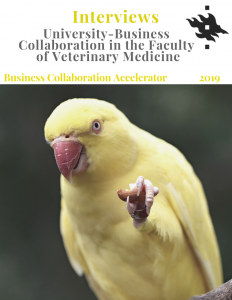Interview with Hankkija’s R&D Director Juhani Vuorenmaa and Development Manager Marjut Suokanto
During the beginning of the snowy 2018 Christmas holidays, I visited Hankkija’s Head Office located in Hyvinkää. I was warmly welcomed by Development Manager Marjut Suokanto and R&D Director Juhani Vuorenmaa. Researchers of the Faculty of Veterinary Medicine are already well known within Hankkija’s walls and keep well apprised of university-business collaborations.
Could you tell us something more about Hankkija? Particularly about your R&D strategy?
Hankkija Oy is an agribusiness company, including supplies sales to farmers. The biggest department is feed; the only department in which production is involved. This also means that R&D activities are only conducted in this area.
Hankkija’s R&D strategy is, in practice, divided into two slightly different sectors. The first one is the development of feed and feed ingredients’ production for farmers. The second sector includes development of natural feed additives and ingredients, especially for more sustainable agriculture.
When it comes to domestic feed production and related R&D, Hankkija strives to help their customers to succeed in farming, improve profitability of their businesses by better performance, improved animal health, and reduce adverse environmental effects. All these have many connections to the food industry and lead to close cooperation with the supply chain, i.e. slaughterhouses, dairy farms etc.
In feed development, one of Hankkija’s large research partners is Schothorst Feed Research (Schothorst Feed Research B.V.) from the Netherlands. They help Hankkija evaluate raw ingredients, optimize feed, and set balanced nutrient requirements for livestock. In addition, they conduct joint trials in order to reduce costs.
Regarding food additives, the general aim is to improve the sustainability of livestock rearing. The related R&D facilitates the export of food additives to different countries. Hankkija’s network has been expanding from Europe to the U.S., Mexico, Latin America, South-East Asia, i.a.
Furthermore, part of Hankkija’s R&D involves proving the benefits of their existing products in different applications to support sales, attract potential customers, and develop new additives, thereby extending their product portfolio.
“If you can find partners for the cost sharing, you can do much more than just by yourself.”
Why do you collaborate with research organizations?
Hankkija does research collaboration for multiple reasons. The first one is reliance on outsourced R&D results. In the past they had their own research farm, “…but running the farm was too expensive”, says Juhani Vuorenmaa. Once they decided to close the farm, they needed facilities for livestock performance trials elsewhere. Research conducted by Hankkija’s partners, that employ development managers responsible for specific fields, enables Hankkija to look into wide range of topics. During the past 20 years, they have developed a strong network of research collaborators, consisting of universities, research organizations, and companies; each of them having expertise in different fields.
Another, perhaps even more important aspect, is in feed development where one needs expertise in various disciplines, that would otherwise be very difficult (or at least far too costly) to attain by any single company. “It is much better to find partners who specialize in certain fields (immunology, microbiology etc.) and then build a long-term strategic partnerships”, Juhani Vuorenmaa explains. In addition to expertise, partners possess premises, equipment and years of experience. As a result, Hankkija can utilize external sources in their own development at reasonable costs. Their role is then to know what they are aiming to accomplish and coordinate the network accordingly.
The next important aspect is funding. Partnering allows Hankkija to share research costs that are increasing all the time. “If you can find partners for the cost sharing, you can do much more than just by yourself”, Vuorenmaa claims. One example, is a piglet study that they are starting with their Dutch partners in February 2019. All the parties obtain results and share the costs of the trials.
Do you think that the university-industry collaboration has an impact on society, environment or animal welfare?
In the first place, collaboration enables Hankkija to work better than working alone. They gain knowledge, create new jobs (e.g. in production, R&D or export sales), and export incomes by collaborating.
Results from Hankkija’s collaborations have reduced reliance on the use of antibiotics, yielding improved animal welfare. Moreover, the ‘1Health’ concept is taken into account, i.e. the reduction of antibiotics resistance having an impact on human health.
Regarding the environmental impact, the reduction of phosphorus and nitrogen output from animals by optimizing feeds is also a positive result.
Based on your own experience, which qualities should a good collaborative partner have?
Firstly, expertise and knowledge is a starting point, as well as facilities (not only animal trial facilities but also laboratories of various kinds).
Good communication skills are also key. Sometimes Hankkija has problems understanding what their partners are doing, especially if they are specialized in a narrowly specified field. At the same time, the researchers have difficulties understanding business. Everything Hankkija researches is connected to commercialization. Every now and then they do sponsor basic research, but in general research should be practical and have application.
In addition, it is useful, from Hankkija’s point of view, when research institutes communicate ideas for research collaboration in a timely manner. Very often, when there is a funding deadline approaching, Hankkija gets a variety of requests from different institutes with ideas for collaboration. Unfortunately, limited time resources may prevent the participation of Hankkija. The company cannot influence the research plan at such a late date.
Could you give an example of a success story?
With University of Helsinki Hankkija has been mainly collaborating with the Faculty of the Veterinary Medicine. There has been a good track record of cooperation with the veterinarians, because they challenge Hankkija to improve feed. Through this they’ve gained a lot of new understanding and knowledge.
For example, some years ago in collaboration with Hankkija, Claudio Oliviero investigated the effects of fibre in feed on sows during the farrowing period. “The results of the study have been applied to Hankkija’s feed manufacturing and have also enriched the field and influenced other researchers as well as feed manufacturers”, describes Marjut Suokanto.
Do researchers themselves inquire about possible cooperation on research projects with you?
“Yes”, says Juhani Vuorenmaa, “…and nowadays more and more.” Hankkija often hears from researchers at the Faculty of Veterinary Medicine who want to discuss new project ideas and discover mutual interests. However, this is not the case for all research groups and universities.
The latest promising inquiry Hankkija has received is from the Natural Resources Institute Finland (Finnish abbr. “Luke”).
“I would suggest to be more active, discuss with companies more and early enough.”
What advice would you give researchers planning collaboration with companies?
According to Hankkija’s experience, the scientific part of a project is usually done perfectly. The research groups do their job well. However, there is room for improvement in other areas.
Juhani Vuorenmaa mentions, “I would suggest to be more active, discuss with companies more and early enough.” It’s a good idea and timely to join the discussion in the project planning or project development phase. It’s convenient to combine ideas and see if the project would or would not be beneficial in this early stage.
One thing that is always challenging is communication. Despite regular project meetings and agreements on project steps, it’s often difficult for Hankkija to understand what the research group is actually doing. Therefore there is need for good and unified, but not bureaucratic, reporting. Hankkija likes to see progress of the work, consider eventual adjustments, and have power to influence the direction of projects.

